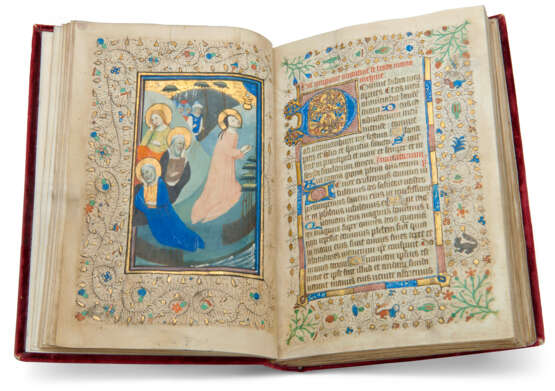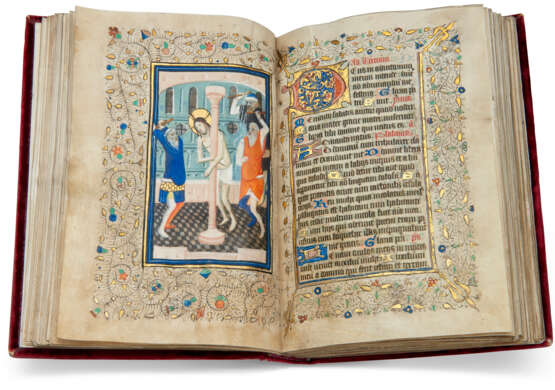ID 993304
Los 43 | Masters of Otto van Moerdrecht
Schätzwert
£ 70 000 – 100 000
Book of Hours, use of Sarum, in Latin, illuminated manuscript on vellum [Bruges, c.1430]
A compelling witness to the international trade in medieval manuscripts: a Book of Hours made in Bruges for the English market, and with early English ownership, splendidly illuminated the Masters of Otto van Moerdrecht, each miniature stamped with a letter 'b', in accordance with Bruges regulations of 1426/1427.
217 x 150mm, ii + 112 + ii leaves: 16, 210(i and vii singletons), 310(vi and ix singletons), 412(ii, v, viii and ix singletons), 59(iii a singleton), 69(viii a singleton), 78, 89(iii a singleton), 98, 109(iii a singleton), 112, 125(i, iii and iv singletons), 134, ff.102-112 uncertain, all miniatures on singletons, 15 lines, ruled space: 146 x 83mm, rubrics and calendar with major feasts in red, text capitals touched red, one-line initials in burnished gold flourished with dark blue or in blue flourished with red, line-endings in red and blue with burnished gold disks, illuminated initials throughout, 14 large illuminated initials and 16 full-page miniatures within full borders, added instruction in 15th-century hand f.81, from f.21 prayers added on miniature rectos or in space on facing versos, initials never supplied (possibly one miniature removed before f.108, many folios darkened, some smudging of borders and occasional damage to miniatures, tarnishing of silver, some original repairs, repaired tear across miniature f.28, holes in some margins including miniature border f.102). Modern red velvet. Fitted red box.
Provenance:
(1) The illumination shows that the manuscript was made in Bruges and some southern Netherlandish or northern French saints appear in the Calendar. The intended market was English, for the Hours of the Virgin and the Office of the Dead are for the use of Sarum and the Calendar has many English feasts, including in red: Edward Martyr (18 March) and translation (20 June), Dunstan (19 May), Augustine, apostle of the English (26 May), Alban (22 June), translation of Thomas Becket (7 July) and feast (29 December), translation of Edward the Confessor (13 October), Edmund (16 November), Hugh (17 November), Edmund Martyr (20 November); also of note in red is St Gereon (10 October), a major patron of Cologne; the presence of St Benedict in red (21 March) and his translation (11 July) may indicate a Benedictine connection. Prayers are in the masculine.
(2) Thomas Bentham: birth entry in Calendar, 24 October 1477
(3) In England at the Reformation when mentions of pope and Thomas Becket scored through; vacat written beside the cancelled feast of the translation of Thomas Becket (7 July), f.4, and his memorial, f.20
(4) Richard Belasyse of Great Haswell, Ludworth and Owton, county Durham (d.1599): the family took their name from Belasyse, county Durham. Richard was one of the eight sons of Richard Belasyse (d.1540) of Henknoll and Margery Errington (d.1587 aged 90), who appear on Margery's brass in the parish church of Houghton-le-Spring. He died unmarried, having made a will in 1597, which named his nephews Bryan and Charles Belasyse and John Pullan as his heirs, specifically bequeathing them all his 'Englishe bookes of storyes, cronykes and others'.
(5) John Pullan or Pulleyn of Scorton (1559-1618): note on f.1 Liber Johannis Pullani ex dono Rechardi Bellasses. John was the son of William Pullan and Margaret Belasyse, Richard's sister, and inherited Scorton and other lands in Yorkshire from his grandfather Walter Pullan in 1580; around 1574 John had married Mary Tempest of Broughton. The Tempests and Pullans were staunch Roman Catholics, so that this book may have been a very practical gift as 'Popish' texts became harder to obtain. Although John Pullan left sons and probably grandsons, who may have inherited the Hours, the Scorton Pullans disappear from the Yorkshire gentry after his death: to meet the heavy fines for non-attendance at church, John had gradually sold all his lands. The Pullans' kinsman Guy Fawkes, whose mother and stepfather lived in Scorton, witnessed the remorseless ruin of otherwise law-abiding relations, along with the more violent sufferings of the Roman Catholic missionary priests, and tried to end the Protestant Establishment in the Gunpowder Plot of 1605; in 1591, John Pullan and Guy Fawkes were each left a gold ring by their connection Richard Burnand of Knaresborough (see C. Pullein, The Pulleyns of Yorkshire, 1915, pp.39-130, with reproduction of John Pullman's signature, p.121).
(6) William Alfred Westropp Foyle (1885-1963): red leather bookplate on front pastedown. His sale at Christie's, 11-13 July 2000, lot 54.
Content:
Calendar ff.1-6; Hours of the Virgin, use of Sarum ff.8-40v: matins f.8, lauds f.14, followed by Memorials to the Saints f.18, prime f.23, terce f.26, sext f.29, none f.32, vespers f.35, compline f.38; prayer in verse to be said before an image of the Virgin, Salve virgo virginum stella matutina, ff.42-45; O Intemerata ff.45-46; Obsecro te ff.46-47v; indulgenced prayer on the Seven Joys of the Virgin, Virgo templum trinitatis, ff.48-49v; sequence of prayers to the crucified Christ, the Cross, His wounds, Omnibus consideratis paradisus voluptatis, ff.49v-51; prayer on the Seven Last Words attributed to Bede, recitation will give protection against human and diabolic enemies, prevent an unconfessed death and ensure a vision of the Virgin 20 days before death, and other prayers ff.51-54; Seven Penitential Psalms ff.56-60v; incipits of first twelve Gradual Psalms and last three in full ff.60v-62; Litany and prayers ff.62-66v; Office of the Dead, use of Sarum, ff.68-83; Commendation of Souls ff.85-92v; Psalter of St Jerome ff.94-101; Suffrages to Sts John the Baptist, f.103, Christopher, f.105, and Anne, f.107; 15 Oes of St Bridget, O jhesu christe eterna dulcedo, ff.108-112; Gaude flore virginali added with text capitals touched yellow, f.112 r&v.
This book was carefully compiled for the English market from texts for the use of Sarum or especially popular in England, like the Commendation of Souls, the Psalter of St Jerome, the verse prayer to the Virgin, that on the Seven Joys and the sequence related to the Passion.
Illumination:
The full-page miniatures on inserted leaves are in the distinctive style of the Masters of Otto van Moerdrecht, named from this canon of Utrecht Cathedral’s gift to the nearby Charterhouse of a Postilla in Prophetas by Nicolaus de Lyra (Universiteitsbibliotheek Utrecht Hs. 252). Active from the 1420s in Utrecht, the Moerdrecht Masters also moved into Brabant and Flanders, where some of their miniatures were stamped (note the very faint red 'b' in the lower right margins of the miniature leaves in the present manuscript), as required in Bruges by regulations of 1426/1427 to control the import of miniatures from Utrecht and elsewhere (S. van Bergen, ‘The Use of Stamps in Bruges Book Production,’ Books of Hours Reconsidered, ed. S. Hindman and J. Marrow, 2013, pp. 323-337). The regulations were clearly ignored, since only twenty-five other manuscripts and four single leaves are known with stamps, most by the Moerdrecht Masters and many for the English export market. The present manuscript has all the hallmarks of the Moerdrecht Masters' style: simplified, elongated figures set in summary landscapes against skies of burnished gold. The intrusion of the Coronation of the Virgin from an Infancy-Virgin cycle into the Passion cycle illustrating the Hours of the Virgin is unusual: the book may have been assembled from pre-fabricated miniatures in some haste, an inference strengthened by the adaptation of a Mary Magdalen to serve as St Anne, the mother of the Virgin, whose cult was only beginning its rapid gain in popularity in the first half of the 15th century. Her inclusion suggests that the book was written to order but that the commissioner would not wait for a new miniature to be painted.
The subjects of the full-page miniatures with borders are as follows: Agony in the Garden f.7v; Arrest of Christ f.13v; Coronation of the Virgin f.22v; Flagellation f.25v; Carrying of the Cross f.28v; Crucifixion f.31v; Dead Christ supported by an angel and surrounded by instruments of the Passion f.34v; Entombment f.37v; Death of the Virgin f.41v; Last Judgement f.55v; Mourners and clerics around a draped coffin in a church f.67v; Souls borne aloft by angels above the general resurrection f.84v; St Jerome f.93v; St John the Baptist f.102v; St Christopher f.104v; St Anne, unusually youthful and virginally bareheaded because she was originally a Mary Magdalen, converted by the erasure of her ointment pot and the addition of a scroll Sancta anna f.106v.
The large initials with bars and full borders are on ff.8, 14, 23, 26, 29, 31, 35, 38, 42, 56, 68, 85, 94, and 108.
Special notice
No VAT is payable on the hammer price or the buyer's premium for this lot. Please see the VAT Symbols and Explanation section of the Conditions of Sale for further information
| Herkunftsort: | Belgien, Westeuropa, Europa |
|---|---|
| Kategorie des Auktionshauses: | Handschriften des Mittelalters und der Renaissance |
| Herkunftsort: | Belgien, Westeuropa, Europa |
|---|---|
| Kategorie des Auktionshauses: | Handschriften des Mittelalters und der Renaissance |
| Adresse der Versteigerung |
CHRISTIE'S 8 King Street, St. James's SW1Y 6QT London Vereinigtes Königreich | |
|---|---|---|
| Vorschau |
| |
| Telefon | +44 (0)20 7839 9060 | |
| Aufgeld | see on Website | |
| Nutzungsbedingungen | Nutzungsbedingungen |








